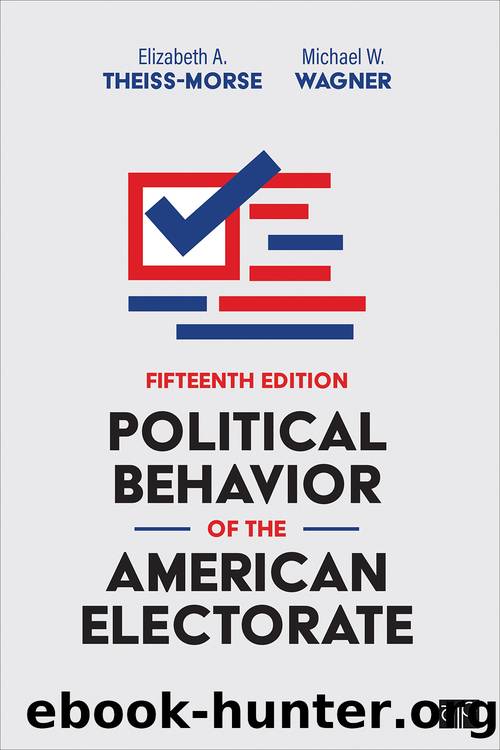Political Behavior of the American Electorate by unknow

Author:unknow
Language: eng
Format: epub
ISBN: 9781071822180
Publisher: Sage
Published: 2021-12-21T20:43:28+00:00
Changes in Individuals Over a Lifetime
Two types of change in partisan identification can be distinguished, both of which have significant implications for political behavior. First, an individual may change from one party to another or to independent or from independence to partisanship. Such change is important if a large proportion of the electorate shifts in the same direction at about the same time. Second, an individualâs partisanship may strengthen or weaken in intensity. A long-standing hypothesis states that the longer individuals identify with a party, the stronger their partisanship will become.31 In the electorate as a whole, the two types of change are not necessarily related to one another, so the occurrence of one form of change does not dictate or prevent the other. For example, recent decades saw an increase in the number of independents in the electorate, which can be accounted for by young people not choosing a party or by partisans moving to independence or both. At the same time, the remaining partisans have become more firmly committed and more party loyal, and polarization between the parties has increased.
Analysts have attempted to explain partisan change by referring to three types of causal effects: (1) period effects, or the impact of a particular historical period that briefly affects partisanship across all age groups; (2) a generation effect, which affects the partisanship of a particular age group for the remainder of their political lives; and (3) a life-cycle effect, which produces changes associated with an individualâs age. In current political behavior, all three can be illustrated: a period effect that resulted in increased independence in all age groups, a generation effect that keeps Democratic partisan loyalty high in the generation that entered the electorate during the New Deal, and a life-cycle effect that yields greater independence among the young than among their elders.
The change in particular age cohorts is worth considering. For example, the youngest age cohort in 1972 was more than forty years old in 1992 and had a lower level of independence than it did when entering the electorate. By 2012, that same cohort was more than sixty years old and had stayed about the same in its level of independence. How do age cohorts identify as independents today? The difference between those thirty and under, those thirty-one to fifty-nine, and those over sixty in the proportion of independents in various age groups is shown in Figure 5-10. In 2020, the younger the cohort, the higher the percentage of people who identified themselves as independents. Of those under thirty, 37.2 percent did not prefer to affiliate with a party as compared to only 26.4 percent of those over sixty.
Figure 5-10 Distribution of Independents, by Age Cohorts, 2020
Source: American National Election Studies, available at www.electionstudies.org.
Download
This site does not store any files on its server. We only index and link to content provided by other sites. Please contact the content providers to delete copyright contents if any and email us, we'll remove relevant links or contents immediately.
Adding Value to Policy Analysis and Advice by Claudia Scott; Karen Baehler(482)
Race and American Political Development by unknow(465)
Sociological Perspectives of Health and Illness by Constantinos N. Phellas(462)
American Government and Politics Today by Steffen W. Schmidt Mack C. Shelley Barbara A. Bardes(453)
Human and Global Security : An Exploration of Terms by Peter Stoett(444)
Entrepreneurship Education and Training: The Issue of Effectiveness by Colette Henry Frances Hill Claire Leitch(437)
Control Of Oil - Hardback by Kayal(426)
Materializing the Middle Passage by Jane Webster;(422)
Advances in Child Development and Behavior, Volume 37 by Patricia J. Bauer(381)
The Catholic Church and European State Formation, AD 1000-1500 by Jørgen Møller(374)
The World According to China by Elizabeth C. Economy(360)
Left Is Not Woke by Susan Neiman(345)
Theories of Counseling and Psychotherapy: A Case Approach by Nancy L. Murdock(342)
Turkey's Relations with the West and the Turkic Republics: The Rise and Fall of the Turkish Model by Idris Bal(337)
The Disappearance of Rituals: A Topology of the Present by Byung-Chul Han(333)
Cross-Cultural Child Development for Social Workers by Lena Robinson(330)
Application of classical statistics, logratio transformation and multifractal approaches to delineate geochemical anomalies in the Zarshuran gold district, NW Iran by unknow(322)
Japan's Ainu Minority in Tokyo by Mark K. Watson(315)
Laboratory Life by Bruno Latour(311)
